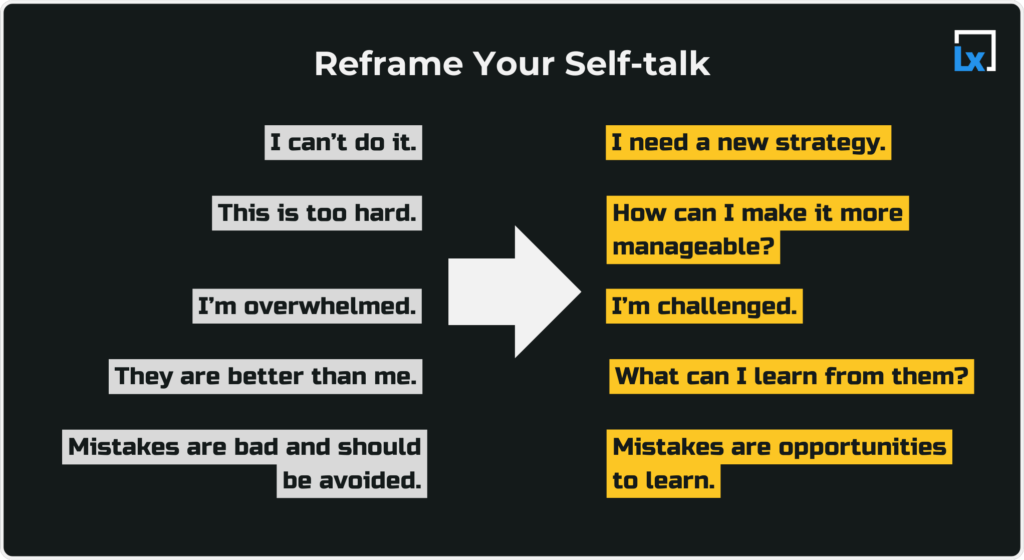Content Focus
Lesson Overview
This part will explain this week’s content focus point. Emotional agility is a process that helps control emotions and manage stress. Mindset is a motivational theory claiming that how people think affects their performance. These two concepts are a part of self-regulation, the second component of emotional intelligence. This lesson will summarize all the ideas you discussed in this chapter.
In this lesson, you will:
- review the process of emotional agility;
- review the Mood Meter tool;
- review the two types of mindset;
- review how to disagree and resolve conflicts.
Video: The Two Mindsets
This week, you are learning about the theory of mindset. The video below provides the definition of mindset and contrasts the two different types of mindset. Watch the video below to review this week’s focus point.
Watch the video below and focus on answering the question: what is mindset? How are fixed and growth mindsets different?
Time limit: 0
Quiz Summary
0 of 6 Questions completed
Questions:
Information
You have already completed the quiz before. Hence you can not start it again.
Quiz is loading…
You must sign in or sign up to start the quiz.
You must first complete the following:
Results
Quiz complete. Results are being recorded.
Results
0 of 6 Questions answered correctly
Your time:
Time has elapsed
You have reached 0 of 0 point(s), (0)
Earned Point(s): 0 of 0, (0)
0 Essay(s) Pending (Possible Point(s): 0)
Categories
- Not categorized 0%
- 1
- 2
- 3
- 4
- 5
- 6
- Current
- Review
- Answered
- Correct
- Incorrect
-
Question 1 of 6
1. Question
CorrectIncorrect -
Question 2 of 6
2. Question
CorrectIncorrect -
Question 3 of 6
3. Question
CorrectIncorrect -
Question 4 of 6
4. Question
CorrectIncorrect -
Question 5 of 6
5. Question
CorrectIncorrect -
Question 6 of 6
6. Question
CorrectIncorrect
Reframing Technique
Reading
Review
7 min
Review the technique by reading about it. After this, complete the task.
One of the most well-known authors who suggest using reframing is Carol Dweck, a professor at Stanford University and the author of “Mindset: How You Can Fulfill Your Potential.” Together with her colleague Claudia Mueller, Dweck studied how beliefs affected performance in children. They discovered that kids who believed they were smart did worse and showed less determination than kids who thought they worked hard.
Dweck’s subsequent experiments proved that reframing from “I am smart and talented” into “If I work hard, I can achieve things” significantly improved people’s performance. In her book, Dweck explains that shifting our thoughts from what we can’t change (the lack of talent or IQ) to something within our control (how much effort we invest) can result in higher motivation and productivity, leading to greater results.

As part of another reframing strategy, Carol Dweck suggests adding “yet” to self-limiting thoughts. She calls it “The Power of Yet.” For example, instead of thinking, “I am not good at Math,” think, “I am not good at Math, yet.” It will help you turn a rigid, unchanging statement into a “work in progress.” This mindset shift will show you that everything is achievable if only you try hard enough.
To learn more about this strategy, read the full article on the blog.
Time limit: 0
Quiz Summary
0 of 1 Questions completed
Questions:
Information
You have already completed the quiz before. Hence you can not start it again.
Quiz is loading…
You must sign in or sign up to start the quiz.
You must first complete the following:
Results
Quiz complete. Results are being recorded.
Results
0 of 1 Questions answered correctly
Your time:
Time has elapsed
You have reached 0 of 0 point(s), (0)
Earned Point(s): 0 of 0, (0)
0 Essay(s) Pending (Possible Point(s): 0)
Categories
- Not categorized 0%
- 1
- Current
- Review
- Answered
- Correct
- Incorrect
-
Question 1 of 1
1. Question
CorrectIncorrect
Reflection: Fixed Mindset
Scientists claim that reflecting on personal actions is one of the effective ways to improve. Read the prompt about mindsets and write your thoughts. You can also complete this task in your guide.
Reflection
3 min
Time limit: 0
Quiz Summary
0 of 1 Questions completed
Questions:
Information
You have already completed the quiz before. Hence you can not start it again.
Quiz is loading…
You must sign in or sign up to start the quiz.
You must first complete the following:
Results
Quiz complete. Results are being recorded.
Results
0 of 1 Questions answered correctly
Your time:
Time has elapsed
You have reached 0 of 0 point(s), (0)
Earned Point(s): 0 of 0, (0)
0 Essay(s) Pending (Possible Point(s): 0)
Categories
- Not categorized 0%
- 1
- Current
- Review
- Answered
- Correct
- Incorrect
-
Question 1 of 1
1. Question
Grading can be reviewed and adjusted.Grading can be reviewed and adjusted.
Lesson Wrap-up
In this lesson, you have reviewed this week’s focus content – emotional intelligence and its first component, self-awareness. Having finished this lesson, you can move on to the first checkpoint – Check Yourself! Review the concepts from today’s lesson:
- emotional intelligence
(n) ability to understand own and others' emotions and act accordingly.
- self-awareness
(n) the ability to see ourselves clearly by understanding who we are, how others see us, and how we fit into the world.
- trigger
emotional ~ (n) something that pushes us to experience negative feelings, such as anxiety, stress, fear, sadness, etc.
- perspective
(n) point of view, opinion
- constructive
(adj) having a useful and helpful effect rather than being negative or with no purpose
- victim mentality
(n) the way of thinking when you tend to blame other people or events for everything negative that happens to you